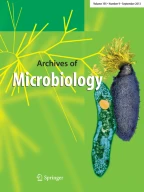Abstract
A stabilized consortium of microbes which anaerobically degraded benzoate and produced CH4 was established by inoculation of a benzoate-mineral salts medium with sewage sludge; the consortium was routinely subcultured anaerobically in this medium for 3 years. Acetate, formate, H2 and CO2 were identified as intermediates in the overall conversion of benzoate to CH4 by the culture. Radioactivity was equally divided between the CH4 and CO2 from the degradation of uniformly ring-labeled [14C]benzoate. The methyl group of acetate was stoichiometrically converted to CH4. Acetate, cyclohexanecarboxylate, 2-hydroxycyclohexanecarboxylate, o-hydroxybenzoic acid and pimelic acid were converted to CH4 without a lag suggesting that benzoate was degraded by a reductive pathway. Addition of o-chlorobenzoate inhibited benzoate degradation but not acetate degradation or methane formation. Two methanogenic organisms were isolated from the mixed culture, neither organism was able to degrade benzoate, showing that the methanogenic bacteria served as terminal organisms of a metabolic food chain composed of several organisms. Removal of intermediates by the methanogenic bacteria provided thermodynamically favorable conditions for benzoate degradation.
Similar content being viewed by others
References
Anonymous: Standard oxidation-reduction potentials of inorganic systems and dyes. In: Biochemists handbook, C. Long, ed., p. 88. Princeton: Van Nostrand 1961
Barker, H. A.: Biological formation of methane. Ind. Engng. Chem. 48, 1438–1442 (1956)
Blair, G. A., Saunders, K. J.: A convenient method for the preparation of DL-5-methyltetrahydrofolic acid (DL-5-methyl-5,6,7,8-tetrahydroptero, 1-l-monoglutamic acid). Analyt. Biochem. 39, 376–381 (1970)
Bryant, M. P., Burkey, L. A.: Cultural methods and some characteristics of some of the more numerous groups of bacteria in the bovine rumen. J. Dairy Sci. 36, 205–217 (1953)
Bryant, M. P., Robinson, I. M.: An improved nonselective culture medium for ruminal bacteria and its use in determining diurnal variation in numbers of bacteria in the rumen. J. Dairy Sci. 44, 1446–1456 (1961)
Bryant, M. P., Wolin, E. A., Wolin, M. J., Wolfe, R. S.: Methanobacillus omelianskii, a symbiotic association of two species of bacteria. Arch. Mikrobiol. 59, 20–31 (1967)
Clark, F. M., Fina, L. R.: The anaerobic decomposition of benzoic acid during methane fermentation. Arch. Biochem. 36, 26–32 (1952)
Dutton, P. L., Evans, W. C.: The metabolism of aromatic compounds by Rhodopseudomonas palustris. Biochem. J. 113, 525–536 (1969)
Ferry, J. G., Smith, P. H., Wolfe, R. S.: Methanospirillum, a new genus of methanogenic bacteria, and characterization of Methanospirillum hungatii sp. nov. Int. J. syst. Bact. 24, 465–469 (1974)
Fina, L. R., Fiskin, A. M.: The anaerobic decomposition of benzoic acid during methane fermentation. II. Fate of carbons one and seven. Arch. Biochem. Biophys. 91, 163–165 (1960)
Hungate, R. E.: The anaerobic mesophilic cellulolytic bacteria. Bact. Rev. 14, 1–49 (1950)
Hungate, R. E.: Hydrogen as an intermediate in the rumen fermentation. Arch. Mikrobiol. 59, 158–164 (1967)
Lowry, O. H., Rosebrough, N. J., Farr, A. L., Randall, R. J.: Protein measurement with the folin phenol reagent. J. biol. Chem. 193, 265–275 (1951)
Mylroie, R. L., Hungate, R. E.: Experiments on the methane bacteria in sludge. Canad. J. Microbiol. 1, 55–64 (1954)
Nottingham, P. M., Hungate, R. E.: Methanogenic fermentation of benzoate. J. Bact. 98, 1170–1172 (1969)
O'Brien, W. E., Ljungdahl, L. G.: Fermentation of fructose and synthesis of acetate from carbon dioxide by Clostridium formicoaceticum. J. Bact. 109, 626–632 (1972)
Pretorius, W. A.: The effect of formate on the growth of acetate utilizing methanogenic bacteria. Water Res. 6, 1213–1217 (1972)
Rabinowitz, J. C., Pricer, W. E., Jr.: Formate. In: Methods of enzymatic analysis, H. V. Bergmeyer, ed., pp. 308–312. New York: Academic Press 1965
Rogosa, M., Love, L. L.: Direct quantitative gas chromatographic separation of C2-C6 fatty acids, methanol, and ethyl alcohol in aqueous microbial fermentation media. Appl. Microbiol. 16, 285–290 (1967)
Rose, I. A., Grunberg-Manago, M., Korey, S. R., Ochoa, S.: Enzymatic phosphorylation of acetate. J. biol. Chem. 211, 737–756 (1954)
Stadtman, T. C., Barker, H. A.: Studies on the methane fermentation. IX. The origin of methane in acetate and methanol fermentation by Methanosarcina. J. Bact. 61, 81–86 (1951)
Tarvin, D., Buswell, A. M.: The methane fermentation of organic acids and carbohydrates. J. Amer. chem. Soc. 56, 1751–1755 (1934)
Taylor, B. F., Campbell, W. L., Chinoy, I.: Anaerobic degradation of the benzene nucleus by a facultatively anaerobic microorganism. J. Bact. 102, 430–437 (1970)
Taylor, B. F., Heeb, J. J.: The anaerobic degradation of aromatic compounds by a denitrifying bacterium. Arch. Mikrobiol. 83, 165–171 (1972)
Williams, R. J., Evans, W. C.: Anaerobic metabolism of aromatic substrates by certain microorganisms. Biochem. soc. Transact. 1, 186–187 (1973)
Wolfe, R. S.: Microbial formation of methane. Advance Microbiol. Physiol. 6, 107–145 (1971)
Wolin, E. A., Wolin, M. J., Wolfe, R. S.: Formation of methane by bacterial extracts. J. biol. Chem. 238, 2882–2886 (1963)
Author information
Authors and Affiliations
Rights and permissions
About this article
Cite this article
Ferry, J.G., Wolfe, R.S. Anaerobic degradation of benzoate to methane by a microbial consortium. Arch. Microbiol. 107, 33–40 (1976). https://doi.org/10.1007/BF00427864
Received:
Issue Date:
DOI: https://doi.org/10.1007/BF00427864
